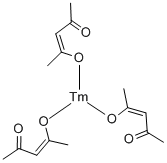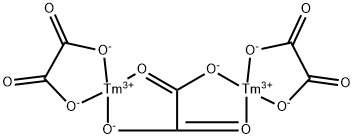THULIUM
Synonym(s):Thulium;
- CAS NO.:7440-30-4
- Empirical Formula: Tm
- Molecular Weight: 168.93
- MDL number: MFCD00011281
- EINECS: 231-140-2
- SAFETY DATA SHEET (SDS)
- Update Date: 2024-12-18 14:15:30

What is THULIUM?
Chemical properties
grey chips
Physical properties
Thulium is a naturally occurring rare metal that exists is very small amounts mixed withother rare-earths. It is a bright silvery metal that is malleable and ductile and can be cuteasily with a knife. Its melting point is so high that it is difficult to force it into a meltedstate. Its vapor pressure is also high, and thus, much of the molten thulium evaporates intothe atmosphere. Its melting point is 1,545°C, its boiling point is 2,950°C, and its density is9.32g/cm3.
Isotopes
There are a total of 46 isotopes of thulium. One of these, Tm-169 is the onlystable isotope of thulium and accounts for the total atomic mass of the element. All theother isotopes are artificially produced and radioactive and have half-lives ranging from afew microseconds to two years.
Origin of Name
Named for Thule, the Greek word for Scandinavia, the most northerly habitable land in ancient mythology.
Occurrence
Thulium is the 61st most abundant element in the Earth’s crust and is found along withother rare-earths in monazite sand, which is about 50% rare-earths by weight. Only about0.007% of this is thulium. It is also found in bastnasite ore. It ranks 16th out of the 17 rareearthsin abundance. Thulium is usually found as an oxide along with other rare-earths. Likemost rare-earths, thulium can be separated from its ore by the ion-exchange process, whereits positive ion reacts with elements with negative ions like fluorine, chlorine, or oxygen toform binary compounds (e.g., Tm2O2). It can also be recovered as a by-product of the nuclearfission reaction in nuclear reactors.
History
Discovered in 1879 by Cleve. Thulium occurs in small quantities along with other rare earths in a number of minerals. It is obtained commercially from monazite, which contains about 0.007% of the element. Thulium is the least abundant of the rare-earth elements, but with new sources recently discovered, it is now considered to be about as rare as silver, gold, or cadmium. Ion-exchange and solvent extraction techniques have recently permitted much easier separation of the rare earths, with much lower costs. Only a few years ago, thulium metal was not obtainable at any cost; in 1996 the oxide cost $20/g. Thulium metal powder now costs $70/g (99.9%). Thulium can be isolated by reduction of the oxide with lanthanum metal or by calcium reduction of the anhydrous fluoride. The pure metal has a bright, silvery luster. It is reasonably stable in air, but the metal should be protected from moisture in a closed container. The element is silver-gray, soft, malleable, and ductile, and can be cut with a knife. Forty-one isotopes and isomers are known, with atomic masses ranging from 146 to 176. Natural thulium, which is 100% 169Tm, is stable. Because of the relatively high price of the metal, thulium has not yet found many practical applications. 169Tm bombarded in a nuclear reactor can be used as a radiation source in portable X-ray equipment. 171Tm is potentially useful as an energy source. Natural thulium also has possible use in ferrites (ceramic magnetic materials) used in microwave equipment. As with other lanthanides, thulium has a low-to-moderate acute toxicity rating. It should be handled with care.
Characteristics
Thulium is near the end of the lanthanide series, where the metals tend to be heavier thanthe ones located near the beginning of the series. It is so scarce that it requires the processing ofabout 500 tons of earth to extract four kilograms of thulium. The only element that is scarceris promethium, which is not found naturally on Earth.
The Uses of THULIUM
Thulium(III) carbonate hydrate has specialized uses in ceramics, glass, phosphors, lasers, and also is the important dopant for fibre amplifiers. Thulium(III) carbonate hydrate has use in ferrites, ceramic magnetic materials that are used in microwave equipment.
The Uses of THULIUM
Ferrites, X-ray source.
The Uses of THULIUM
Thulium is relatively scarce and expensive, which limits its commercial uses. Thulium-170,which is a radioactive isotope of thulium produced by fission in nuclear reactors, can be usedas small, portable X-ray sources. It also has limited use as an alloy metal with other metals andhas experimentally been used in lasers. (Note: Of all the isotopes of thulium, only thulium-169 is stable and nonradioactive.)
Definition
Atomic number 69, group IIIB of the periodic table, a rare-earth element of the lanthanide groups, aw168.9342, valence of 3; no stable isotopes.
Definition
A soft malleable ductile silvery element of the lanthanoid series of metals. It occurs in association with other lanthanoids. Symbol: Tm; m.p. 1545°C; b.p. 1947°C; r.d. 9.321 (20°C); p.n. 69; r.a.m. 168.93421.
Definition
thulium: Symbol Tm. A soft greymetallic element belonging to thelanthanoids; a.n. 69; r.a.m. 168.934;r.d. 9.321 (20°C); m.p. 1545°C; b.p.1947°C. It occurs in apatite and xenotime.There is one natural isotope,thulium–169, and seventeen artificialisotopes have been produced. Thereare no uses for the element, whichwas discovered by Per Cleve (1840–1905) in 1879.
What are the applications of Application
Thulium products are mainly used in making crystal and lasers.
An important application of the thulium in the Medicine area, and relatively independent of its high cost, is the production of portable X-ray sources. These sources are available for about one year, as tools in medical and dental diagnosis, as well as to detect defects in mechanical and electronic inaccessible components. This type of sources does not need excessive protection. Usually a small cap of lead is enough. Thulium can also be used in magnetic and ceramic materials (ferrite), similar to the Yttrium-iron alloys, nowadays used in the microwave technologies.
Thulium Metal, is mainly used in making superalloys, and has some application in ferrites (ceramic magnetic materials) used in microwave equipment and also as a radiation source of portable X-ray. Thulium potentially has use in ferrites, ceramic magnetic materials that are used in microwave equipment. it is used in arc lighting for its unusual spectrum.
Production Methods
Thulium is recovered from xenotime, gadolinite, euxenite, samarskite, and other minerals. The first step of recovery involves opening the ores. If xenotime, (Y)PO4 is the starting material, the mineral is heated with an excess of sulfuric acid (95%). The product mixture is treated with cold water to separate water-soluble sulfates from unreacted mineral, silica, and other insoluble residues. The solution is filtered and yttrium and the individual rare earths are separated from this solution by ion exchange. The tripositive lanthanide metal ions and yttrium are absorbed on an appropriate cation exchange column and eluted with ammonium ethylenediamine tetraacetic acid (EDTA) at pH 8.4. The cation-exchange resin is pretreated with an equimolar mixture (1 M) of copper sulfate-sulfuric acid. The various eluate fractions are collected, and are treated with oxalic acid. The metals are precipitated as oxalates. Precipitate from the thulium fraction is calcined at 800°C to convert oxalate into oxide, Tm2O3.
If thulium is to be recovered from gadolinite, Be2Fe(Y)2Si2O10, pulverized mineral is opened by digesting with hot nitric acid-hydrochloric acid mixture. Insoluble silica residues are removed by filtration. The solution now contains beryllium, iron, yttrium, and the rare earths. The solution is treated with oxalic acid to precipitate yttrium and the rare earths. The precipitate is calcined at 800°C to form rare earth oxides. The oxide mixture is dissolved in an acid from which yttrium and the rare earths are separated by the ionexchange as above. Caustic fusion may be carried out instead of acid digestion to open the ore. Under this condition silica converts to sodium silicate and is leached with water. The insoluble residue containing rare earths and yttrium is dissolved in an acid. The acid solution is fed to an ion exchange system for separating thulium from other rare earths,
Thulium metal is prepared from its oxide by reduction with lanthanum at its melting point of 1,545°C. Thulium is separated from lanthanum by sublimation in vacuum. The metal vapor is condensed into crystalline metal in purified form free from lanthanum.
Hazard
Fire risk in form of dust.
Hazard
The dust and powder of thulium are explosive and toxic if inhaled or ingested. As with allradioactive elements, thulium can cause radiation poisoning.
Properties of THULIUM
| Melting point: | 1545 °C (lit.) |
| Boiling point: | 1950 °C (lit.) |
| Density | 9.332 g/mL at 25 °C (lit.) |
| solubility | soluble in dilute acid solutions |
| form | powder |
| color | Silver-gray |
| Specific Gravity | 9.332 |
| Resistivity | 90 μΩ-cm, 20°C |
| Water Solubility | slowly reacts with H2O; soluble in dilute acids [HAW93] |
| Sensitive | Air & Moisture Sensitive |
| Merck | 13,9471 |
| Exposure limits | ACGIH: TWA 2 ppm; STEL 4 ppm OSHA: TWA 2 ppm(5 mg/m3) NIOSH: IDLH 25 ppm; TWA 2 ppm(5 mg/m3); STEL 4 ppm(10 mg/m3) |
| CAS DataBase Reference | 7440-30-4(CAS DataBase Reference) |
| EPA Substance Registry System | Thulium (7440-30-4) |
Safety information for THULIUM
| Signal word | Danger |
| Pictogram(s) |
 Flame Flammables GHS02  Exclamation Mark Irritant GHS07 |
| GHS Hazard Statements |
H228:Flammable solids H260:Substances And Mixtures Which, In Contact With Water,Emit Flammable Gases H319:Serious eye damage/eye irritation H335:Specific target organ toxicity, single exposure;Respiratory tract irritation |
| Precautionary Statement Codes |
P210:Keep away from heat/sparks/open flames/hot surfaces. — No smoking. P223:Keep away from any possible contact with water, because of violent reaction and possible flash fire. P240:Ground/bond container and receiving equipment. P261:Avoid breathing dust/fume/gas/mist/vapours/spray. P280:Wear protective gloves/protective clothing/eye protection/face protection. P231+P232:Handle under inert gas. Protect from moisture. P305+P351+P338:IF IN EYES: Rinse cautiously with water for several minutes. Remove contact lenses, if present and easy to do. Continuerinsing. |
Computed Descriptors for THULIUM
New Products
Tert-butyl bis(2-chloroethyl)carbamate 4-Methylphenylacetic acid N-Boc-D-alaninol N-BOC-D/L-ALANINOL 3-Morpholino-1-(4-nitrophenyl)-5,6-dihydropyridin- 2(1H)-one Furan-2,5-Dicarboxylic Acid Tropic acid 1,1’-CARBONYLDIIMIDAZOLE DIETHYL AMINOMALONATE HYDROCHLORIDE R-2-BENZYLOXY PROPIONIC ACID 1,1’-CARBONYLDI (1,2-4 TRIAZOLE) N-METHYL INDAZOLE-3-CARBOXYLIC ACID (2-Hydroxyphenyl)acetonitrile 4-Bromopyrazole 5-BROMO-2CYANO PYRIDINE 5,6-Dimethoxyindanone 5-broMo-2-chloro-N-cyclopentylpyriMidin-4-aMine 2-(Cyanocyclohexyl)acetic acid 4-methoxy-3,5-dinitropyridine 2-aminopropyl benzoate hydrochloride 1-(4-(aminomethyl)benzyl)urea hydrochloride diethyl 2-(2-((tertbutoxycarbonyl)amino) ethyl)malonate tert-butyl 4- (ureidomethyl)benzylcarbamate Ethyl-2-chloro((4-methoxyphenyl)hydrazono)acetateRelated products of tetrahydrofuran








You may like
-
 Thulium pieces, Sublimed dendritic CAS 7440-30-4View Details
Thulium pieces, Sublimed dendritic CAS 7440-30-4View Details
7440-30-4 -
 Thullium powder, 99.9% CAS 7440-30-4View Details
Thullium powder, 99.9% CAS 7440-30-4View Details
7440-30-4 -
 Thulium CAS 7440-30-4View Details
Thulium CAS 7440-30-4View Details
7440-30-4 -
 Thulium CAS 7440-30-4View Details
Thulium CAS 7440-30-4View Details
7440-30-4 -
 Thulium CAS 7440-30-4View Details
Thulium CAS 7440-30-4View Details
7440-30-4 -
 Thulium CAS 7440-30-4View Details
Thulium CAS 7440-30-4View Details
7440-30-4 -
 Thulium CAS 7440-30-4View Details
Thulium CAS 7440-30-4View Details
7440-30-4 -
 Thulium CAS 7440-30-4View Details
Thulium CAS 7440-30-4View Details
7440-30-4